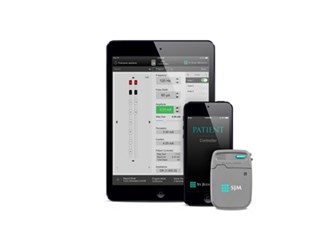FDA Approves First "Smart" Spinal Cord Stimulation Trial System

The FDA has approved St. Jude’s Invisible Trial system, which allows patients to test drive spinal cord stimulation (SCS) therapy before committing to a permanent implant. By incorporating Apple and Bluetooth wireless technology, developers believe they have created a more intuitive and discreet model that will allow patients and physicians to better evaluate the therapy.
While spinal cord stimulation (SCS) has been shown to effectively address chronic pain in patients with certain conditions, it’s not for everyone. A recent report by the American Chronic Pain Association (ACPA) remarked that it is important to fully evaluate the needs and expectations of each patient before having the system surgically implanted.
This evaluation usually involves a trial period of three to five days, which allows patient and physician to test and monitor the system before deciding to proceed with surgery. Traditional trial systems have used an external power source and a remote control to program the amount of stimulation the patient receives.
According to St. Jude group president Eric Fain, these traditional trial systems are bulky and uncomfortable, and the remote controls are overly complex and hard to manage. Experts, who carefully considered feedback from patients and physicians participating in SCS trials, found that bulky and difficult equipment interfered with the evaluation of the therapy.
“Patients undergoing SCS trials consistently tell us about challenges they find in navigating the SCS trial system, from programming the device, to discomfort from the programming cables, to management of both issues,” said Jason Pope, president of Summit Pain Alliance, in a press release. “These hindrances may impede the integration of the technology into their daily activities, which shifts their focus away from evaluating the effectiveness of the SCS therapy.”
By streamlining the trial system, Fain said, “we think we can shorten the learning curve related to trial programming devices and allow patients to better assess the potential pain relief they’re receiving from SCS.”
In order to make the trial system easier to use, St. Jude used an external pulse generator that communicates with the controller using Bluetooth wireless technology, meaning it can safely and discreetly be hidden underneath clothes. The remote control then was incorporated into familiar Apple technology: an IPod touch digital device for patients to control the therapy, and an IPod Mini that allows doctors to monitor progress.
When the system received CE Mark approval in June, German neurosurgeon Stefan Schu told Reuters that the new system was not just more comfortable for the patient, it also was more versatile, providing a wider range of stimulation modes than had previously been available in a trial experience.
The National Institute of Health (NIH) released a report last January in which experts stated that the clinical approach to chronic pain management needed to be re-evaluated, revamped, and pushed beyond traditional pharmaceutical methods.
David Reuben, professor of medicine at David Geffen School of Medicine at the University of California, said in a statement, “Chronic pain spans a multitude of conditions, presents in different ways, and requires an individualized, multi-faceted approach.”
Reuters reported that chronic pain affects 1.5 billion people worldwide.
